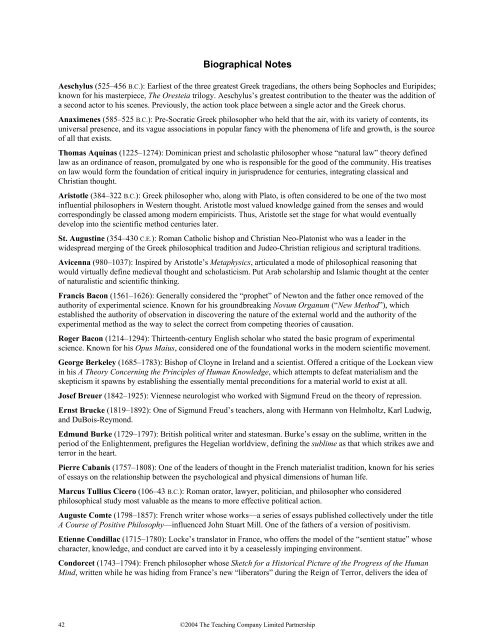Great Ideas of Philosophy
Great Ideas of Philosophy
Great Ideas of Philosophy
- No tags were found...
Create successful ePaper yourself
Turn your PDF publications into a flip-book with our unique Google optimized e-Paper software.
Biographical NotesAeschylus (525–456 B.C.): Earliest <strong>of</strong> the three greatest Greek tragedians, the others being Sophocles and Euripides;known for his masterpiece, The Oresteia trilogy. Aeschylus’s greatest contribution to the theater was the addition <strong>of</strong>a second actor to his scenes. Previously, the action took place between a single actor and the Greek chorus.Anaximenes (585–525 B.C.): Pre-Socratic Greek philosopher who held that the air, with its variety <strong>of</strong> contents, itsuniversal presence, and its vague associations in popular fancy with the phenomena <strong>of</strong> life and growth, is the source<strong>of</strong> all that exists.Thomas Aquinas (1225–1274): Dominican priest and scholastic philosopher whose “natural law” theory definedlaw as an ordinance <strong>of</strong> reason, promulgated by one who is responsible for the good <strong>of</strong> the community. His treatiseson law would form the foundation <strong>of</strong> critical inquiry in jurisprudence for centuries, integrating classical andChristian thought.Aristotle (384–322 B.C.): Greek philosopher who, along with Plato, is <strong>of</strong>ten considered to be one <strong>of</strong> the two mostinfluential philosophers in Western thought. Aristotle most valued knowledge gained from the senses and wouldcorrespondingly be classed among modern empiricists. Thus, Aristotle set the stage for what would eventuallydevelop into the scientific method centuries later.St. Augustine (354–430 C.E.): Roman Catholic bishop and Christian Neo-Platonist who was a leader in thewidespread merging <strong>of</strong> the Greek philosophical tradition and Judeo-Christian religious and scriptural traditions.Avicenna (980–1037): Inspired by Aristotle’s Metaphysics, articulated a mode <strong>of</strong> philosophical reasoning thatwould virtually define medieval thought and scholasticism. Put Arab scholarship and Islamic thought at the center<strong>of</strong> naturalistic and scientific thinking.Francis Bacon (1561–1626): Generally considered the “prophet” <strong>of</strong> Newton and the father once removed <strong>of</strong> theauthority <strong>of</strong> experimental science. Known for his groundbreaking Novum Organum (“New Method”), whichestablished the authority <strong>of</strong> observation in discovering the nature <strong>of</strong> the external world and the authority <strong>of</strong> theexperimental method as the way to select the correct from competing theories <strong>of</strong> causation.Roger Bacon (1214–1294): Thirteenth-century English scholar who stated the basic program <strong>of</strong> experimentalscience. Known for his Opus Maius, considered one <strong>of</strong> the foundational works in the modern scientific movement.George Berkeley (1685–1783): Bishop <strong>of</strong> Cloyne in Ireland and a scientist. Offered a critique <strong>of</strong> the Lockean viewin his A Theory Concerning the Principles <strong>of</strong> Human Knowledge, which attempts to defeat materialism and theskepticism it spawns by establishing the essentially mental preconditions for a material world to exist at all.Josef Breuer (1842–1925): Viennese neurologist who worked with Sigmund Freud on the theory <strong>of</strong> repression.Ernst Brucke (1819–1892): One <strong>of</strong> Sigmund Freud’s teachers, along with Hermann von Helmholtz, Karl Ludwig,and DuBois-Reymond.Edmund Burke (1729–1797): British political writer and statesman. Burke’s essay on the sublime, written in theperiod <strong>of</strong> the Enlightenment, prefigures the Hegelian worldview, defining the sublime as that which strikes awe andterror in the heart.Pierre Cabanis (1757–1808): One <strong>of</strong> the leaders <strong>of</strong> thought in the French materialist tradition, known for his series<strong>of</strong> essays on the relationship between the psychological and physical dimensions <strong>of</strong> human life.Marcus Tullius Cicero (106–43 B.C.): Roman orator, lawyer, politician, and philosopher who consideredphilosophical study most valuable as the means to more effective political action.Auguste Comte (1798–1857): French writer whose works—a series <strong>of</strong> essays published collectively under the titleA Course <strong>of</strong> Positive <strong>Philosophy</strong>—influenced John Stuart Mill. One <strong>of</strong> the fathers <strong>of</strong> a version <strong>of</strong> positivism.Etienne Condillac (1715–1780): Locke’s translator in France, who <strong>of</strong>fers the model <strong>of</strong> the “sentient statue” whosecharacter, knowledge, and conduct are carved into it by a ceaselessly impinging environment.Condorcet (1743–1794): French philosopher whose Sketch for a Historical Picture <strong>of</strong> the Progress <strong>of</strong> the HumanMind, written while he was hiding from France’s new “liberators” during the Reign <strong>of</strong> Terror, delivers the idea <strong>of</strong>42©2004 The Teaching Company Limited Partnership














